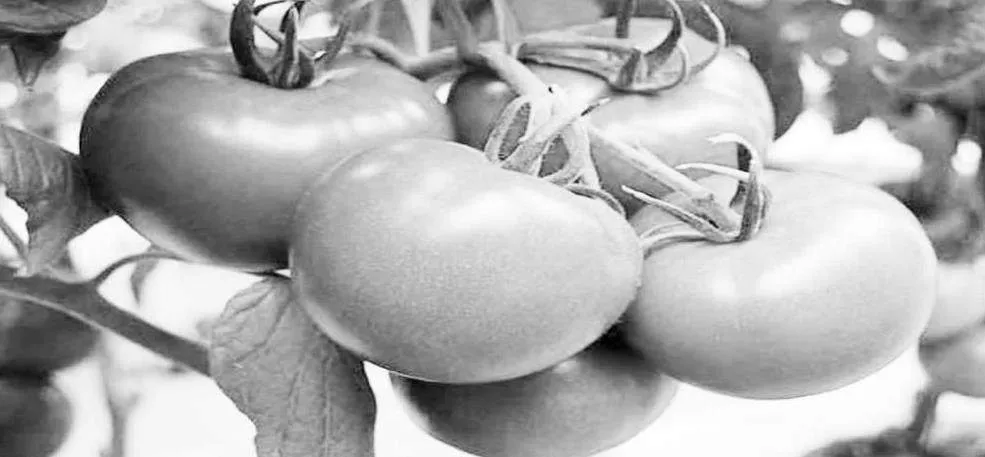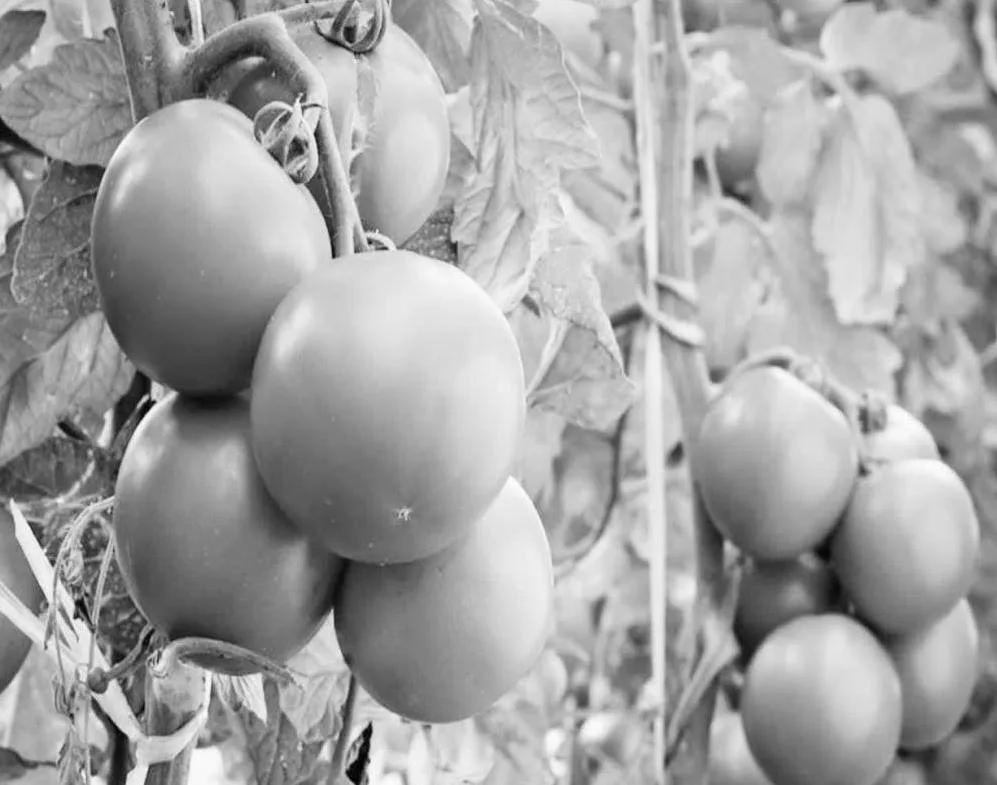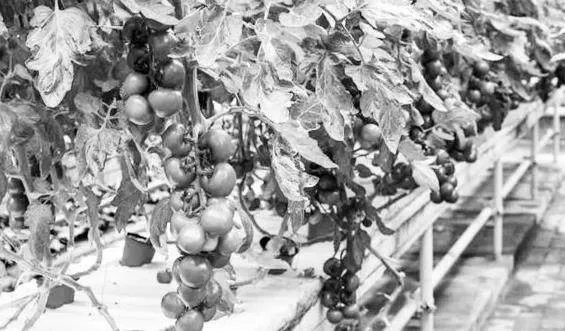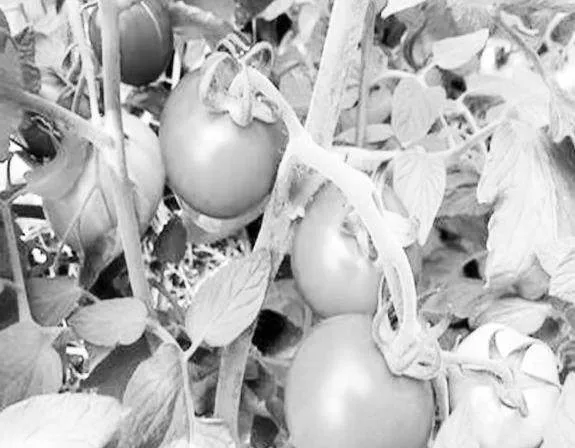




摘要:【目的】研究20份番茄商业种进行遗传多样性,筛选具有特异性抗病性状的番茄商业种,为农户进行品种选购提供指导性意见。【方法】本研究以20个番茄商业种为试验材料借助单核苷酸多态性(SNPs),进行遗传关系聚类、遗传组成成分分析、抗病基因分析及抗病渐渗片段分析。【结果】20个番茄商业种被分为2个类群,源于同一公司的番茄商业种更有可能被分于同一群体,其中中蔬种业科技(北京)有限公司的中蔬4号、中蔬6号和中杂9号在遗传关系聚类和遗传组成成分分析时均被归于同一类型,此外,20个番茄商业种在Mi-1.2、Ty-1/3、Ve三个抗病基因存在基因型差异,通过比较其与渐渗供体材料的基因组相似性,研究发现大部分材料含有Mi、Ty-1、Tm-2和Sw-5的渐渗片段。【结论】20个番茄商业种被分为2个类群,源于同一公司的番茄商业种更有可能被分于同一群体,这些材料特定的抗病基因及抗病基因渐渗片段,将对深入了解品种种质特性,促进农业的发展,增加农民的收入,提高农业生产的效率具有重要的意义。
关键词:番茄;商业品种;遗传多样性;抗病基因
Population diversity analysis of 20 commercial tomato species
Xu Maomao1",Gao Jie1*
("College of Horticulture, Xinjiang Agricultural University, Wulumuqi, 830052)
Abstract: 【Purpose】This study aimed to investigate the genetic diversity of 20 commercial tomato varieties, screen for tomato varieties with specific disease resistance traits, and provide guidance for farmers in variety selection.【Methods】SNP markers were used to analyze the genetic relationship clustering, genetic composition, disease resistance gene analysis, and disease resistance infiltration fragment analysis of 20 commercial tomato varieties.【Results】The 20 commercial tomato varieties were divided into two groups, and tomato varieties from the same company were more likely to be grouped together. Among them, Zhongshu 4, Zhongshu 6, and Zhongza 9 from Zhongshu Seed Industry Technology (Beijing) Co., Ltd. were classified into the same type in genetic relationship clustering and genetic composition analysis. In addition, there were genotype differences in the Mi-1.2, Ty-1/3, and Ve"disease resistance genes among the 20 commercial tomato varieties. By comparing their genome similarity with the infiltrating donor materials, it was found that most materials contained infiltrating fragments of Mi, Ty-1, Tm-2, and Sw-5.【Conclusion】The 20 commercial tomato varieties were divided into two groups, and tomato varieties from the same company were more likely to be grouped together. The specific disease resistance genes and disease resistance infiltration fragments of these materials are of great significance for in-depth understanding of variety germplasm characteristics, promoting agricultural development, increasing farmers income, and improving agricultural production efficiency.
Key Words: Tomatoes; Commercial varieties; Genetic diversity;Anti-disease gene
0"引言
【研究意义】番茄(Solanum lycopersicum L.)是世界上种植面积最大、消费最广泛的蔬菜水果作物之一[1]。它不仅是人类饮食中番茄红素和其他抗氧化剂的主要来源,还被广泛认为是“保护性食品”,能够降低癌症发病率[2]。深入了解品种种质特性,对促进农业的发展,增加农民的收入,提高农业生产的效率具有重要的意义。【前人研究进展】在十三五期间,我国选育的番茄新品种在数量、复合抗病性和品质方面都得到了显著提升。据统计,2020年我国登记的番茄品种数为763个,比2019年增加了66.23%[3]。其中,上海菲图种业有限公司选育的瑞星5号、西安市蔬菜所选育的毛粉802、广州市农业科学研究所选育的益丰、广东省农科院蔬菜所选育的新星101等番茄系列新品种,在抗病性、广适性、商品性和高产性等方面均表现出色[4]。单核苷酸多态性(SNP)是第二类遗传标记,它通过对基因序列进行挖掘,成为对等位基因变异、全基因组定位和标记辅助选择的重要工具。在许多作物中,SNP的高频率存在为遗传定位和标记辅助选择提供了另一种选择[5]。对22种不同基因型的大豆序列多样性研究发现,编码区每kb有1.64个SNP,非编码区每kb有4.85个SNP[6]。Kanazin等人在2002年对大麦的SNP突变率进行了报道,表明该物种中每189个碱基有可能会有1个产生突变[7]。此外,在水稻、大豆和洋葱中也发现了与性状相关的SNP[8]。虽然栽培种番茄由于缺乏遗传变异导致遗传学家主要在野生种的远缘杂交中研究性状变异,但随着番茄基因组序列和大量SNP标记的可用性被证实[9],通过分子生物技术重新检查农艺性状和果实性状的变异和遗传成为可能[10]。此外,随着测序成本的降低,具有准确、快速的基因分型技术使得单核苷酸多态性成为植物高通量分析中最常用的DNA标记,促进了种质资源序列变异的分析及品种识别[11-12]。【本研究切入点】我国不仅是世界番茄最大的生产国家还拥有超过 15 亿元的番茄种子市场[13],然而随着番茄品种数量的增加以及种子市场规模的不断扩增,一些公司为了快速的获取利益,导致拷贝种子、假冒种子以及类型较为相似的商业番茄品种的乱像不可避免的出现了[14-16]。因此,对不同商业番茄品种进行科学分析,为农户进行品种选购提供指导性意见变得尤为必要。【拟解决的关键问题】前人进行番茄育种时,主要基于种植者和消费者需求,对番茄果实质量特征、产量及抗病性进行培育。然而,由于栽培种番茄遗传背景狭窄[17-18],不同品种的商业番茄可能具有类似的表型特征及相近的亲缘关系。因此,本研究利用SNP遗传标记对不同商业番茄品种的遗传关系、遗传物质、抗病基因及抗病渐渗片段进行分析,旨在分子层面上研究这些品种的亲缘关系和遗传多样性,为更好地利用番茄资源做出贡献。
1 材料与方法
1.1试验材料
本试验中所需的20个商业番茄品种见表1,由课题组于市场购买,并于2021年12月播种于顺义试验站育苗温室,待幼苗的第三片真叶长出时进行取样,采用CTAB法进行DNA提取。
1.2 实验方法
本试验以20份番茄商业种为材料,首先,通过对其全基因组变异信息分析并利用 MEGA-X 软件的 Neighbor-joining 方法,进行 5000次 Bootstrap 构建系统发生树对20份番茄商业种进行遗传关系聚类;其次,通过 ADMIXTURE 软件对20份番茄商业种进行群体结构分析,并基于CV error的最低值对其进行群体遗传组成的分析;随后,通过分析主要抗病基因Ty1,Ty2,Ve,I-2,Sm,Pto,Sw-5,Tm-2平均物理距离5MB,次等位基因频率gt;0.1的169个SNP,根据抗病基因等位基因信息对20份番茄商业种进行抗病基因聚类;最后,根据已报道的抗病基因的渐渗片段来源信息[19],比较20份番茄商业种与渐渗供体的基因组相似性。
2. 结果与分析
2.1"遗传关系聚类分析
根据全基因组变异信息,通过使用MEGA-X软件,将20个商业番茄品种主要分为两个类群(图1)。第一类包括12个材料,分别是齐达利、喜来德1号、早粉2号、百利、丰收128、欧盾、SV4224、SV7845TH、倍盈、金鹏1号、思贝德和罗拉,以齐达利为代表。第二类包括8个材料,分别是中蔬4号、天赐575、天赐595、天妃9号、中蔬6号、中杂9号、普罗旺斯和凯德1832,以中蔬6号为代表。
总体而言,大部分源于同一公司的不同品种具有较近的亲缘关系,如先正达种苗(北京)有限公司的齐达利、倍盈、思贝德均位于第1类群;沈阳谷雨种业有限公司的天赐575、天赐595、香妃9号均位于第2类群;中蔬种业科技(北京)有限公司的中蔬4号、中蔬6号和中杂9号也均位于第2类群。然而仍然有一部分番茄品种尽管源于同一公司但亲缘关系较远,如圣尼斯种子(北京)有限公司的欧盾、SV4224和SV7845TH位于第1类群,而普罗旺斯却位于第2类群。
2.2 遗传组成分析
根据基因型变异信息,本研究利用ADMIXTRUE软件对实验材料进行了群体结构遗传分析。计算结果表明,当K为2时,CV_error值最小,表明20份番茄商业种最有可能被分为2个亚群。随后,本研究对所有材料进行了结构分析,发现20份番茄商业种的遗传组成主要有两种类型(A和B)。其中,丰收128、欧盾、金鹏1号、思贝德、喜来德1号、SV4224和SV7845TH的遗传组成主要为A类型,而中蔬4号、中蔬6号和中杂9号的遗传组成主要为B类型。其余商业种则为混合类型。
2.3 抗病基因分析
由于番茄易受200多种害虫和病原体的影响[20],因此本研究根据抗病基因Cf-9、Pto、Cf-2.2、Mi-1.2、Ty-1/3、Ve、Tm-2、Sw-5、Sm、Ty-2、I-2上下游5000bp内的SNP变异,开发了11个分子标记,根据抗病基因等位基因信息将20份番茄商业种进行抗病基因的聚类分析。研究结果表明,20份商业种的抗病基因差异主要体现在Mi-1.2、Ty-1/3、Ve三个抗病基因中,其余抗病基因并不存在基因型差异。
根据抗病基因等位信息,将20份番茄商业品种分成了两类。第一类以天赐595为代表,其余材料包括天赐595、普罗旺斯、天妃9号、中杂9号、凯德1832、天赐575、倍盈、丰收128、欧盾、思贝德、SV7845TH和罗拉。其中,天赐595和天妃9号在Mi-1.2、Ty-1/3、Ve三个抗病基因中的基因型完全一致。普罗旺斯与天赐595和天妃9号相比,Ty-1/3抗病基因的基因型由Y变为T。中杂9号与天赐595和天妃9号相比,Ve抗病基因的基因型由C变为M。天赐575和凯德1832在Mi-1.2、Ty-1/3、Ve三个抗病基因的基因型也完全一致,然而与天赐595和天妃9号相比,Mi-1.2抗病基因的基因型由G变为R。此外,思贝德、SV7845TH和罗拉在Mi-1.2、Ty-1/3、Ve三个抗病基因中的基因型完全一致,然而与天赐595和天妃9号相比,Mi-1.2抗病基因的基因型由G变为A。倍盈、丰收128、欧盾在Mi-1.2、Ty-1/3、Ve三个抗病基因中的基因型完全一致,然而与思贝德、SV7845TH和罗拉相比,Ty-1/3抗病基因的基因型由Y变为T。
第二类以金鹏1号为代表,其余为中蔬4号、中蔬6号、齐达利、喜来德1号、百利、SV4224和早粉2号。其中,中蔬4号和中蔬6号在Mi-1.2、Ty-1/3、Ve三个抗病基因中的基因型完全一致。早粉2号与中蔬4号、中蔬6号相比,Mi-1.2抗病基因的基因型由G变为A。齐达利和喜来得1号在Mi-1.2、Ty-1/3、Ve三个抗病基因中的基因型完全一致,然而与早粉2号相比,Ve抗病基因的基因型由A变为C。百利、SV4224、金鹏1号在Mi-1.2、Ty-1/3、Ve三个抗病基因中的基因型完全一致,然而与齐达利和喜来得1号相比,Ty-1/3抗病基因的基因型由C变为Y,Ve抗病基因的基因型由C变为M。
2.4 渐渗片段分析
根据已报道的抗病基因的渐渗片段,本研究比较了20个商业番茄品种与渐渗供体材料的基因组相似性。结果显示,在与Mi-1供体秘鲁番茄PI 128657的基因组相似性比较中,15个商业番茄品种含有其渐渗片段,分别为天妃9号、天赐575、天赐595、普罗旺斯、倍盈、丰收128、欧盾、凯德1832、中杂9号、金鹏1号、百利、SV4224、SV7845TH、思贝德和罗拉,渐渗长度为32.12Mb-35.16Mb。在与Ty-1供体智利番茄LA1969的基因组相似性比较中,17个商业番茄品种含有LA1969的Ty-1基因部分外源片段,分别为齐达利、喜来德1号、百利、丰收128、欧盾、SV4224、SV7845TH、倍盈、金鹏1号、思贝德、罗拉、天赐575、天赐595、天妃9号、中杂9号、普罗旺斯和凯德1832,渐渗片段的长度为5.01-32.12 Mb。在与Tm-2供体秘鲁番茄PI 128650的基因组相比较中,共发现17个商业番茄品种携带PI 128650 9号染色体的部分外源片段,分别为齐达利、喜来德1号、百利、丰收128、欧盾、SV4224、SV7845TH、倍盈、金鹏1号、思贝德、罗拉、天赐575、天赐595、天妃9号、中杂9号、普罗旺斯和凯德1832,此片段的长度是15.03-40.71Mb。在与Sw-5供体秘鲁番茄PI 126935的基因组相比较中,共发现17个商业番茄品种含有抗Sw-5基因的部分外源片段,分别为齐达利、喜来德1号、百利、丰收128、欧盾、SV4224、SV7845TH、倍盈、金鹏1号、思贝德、罗拉、天赐575、天赐595、天妃9号、中杂9号、普罗旺斯和凯德1832,此片段的长度是5.00-55.74Mb。
3. 讨论
通过这些研究结果,我们可以清晰地了解不同商业番茄品种之间的遗传关系和遗传特征,进而更好地研究番茄的抗病性能。这对于提高番茄产量和品质,保障农民的收益和消费者的健康,都具有非常重要的意义。然而,本研究仍存在局限性。该研究仅涉及20个商业番茄品种,而实际生产和种植中,番茄品种和数量非常丰富。因此,我们需要更深入地探究和研究番茄的遗传特征和抗病性能,以为番茄种植的发展提供更好的支持和指导。
综上所述,通过对20个商业番茄品种进行遗传关系聚类、遗传组成分析、抗病基因分析以及抗病渐渗片段分析,本研究结果具有重要的意义和价值。这项研究不仅为番茄的种植和生产提供有力的支持和指导,同时也为其他作物的种植和研究提供了借鉴和参考。我们需要更深入地探究和研究番茄的遗传特征和抗病性能,以为保障粮食安全和农民的收益做出更大的贡献。
4 结论
本研究以20个番茄商业种为实验材料借助单核苷酸多态性(SNPs),首先,通过对这20个番茄商业种的遗传信息进行比对和分析,将其分为以齐达利为代表和以中蔬6号为代表的两类,并且研究发现,尽管源于同一公司的番茄商业种更容易被分为同一类群,但这并不绝对,同一公司的不同品种的亲缘关系可能会存在差异[14];其次,通过对这20个番茄商业种的遗传组成分析,研究发现K为2时,CV_error的值最小,在该条件下这20个番茄商业种被分为2个亚群,其中B类型的为源于中蔬种业科技(北京)有限公司的中蔬4号、中蔬6号和中杂9号,而它们在遗传关系聚类中均属于第2类,这表明中蔬4号、中蔬6号和中杂9号可能具有较近的亲缘关系;随后,通过对这20个番茄商业种的抗病基因进行分析,研究发现20份商业种的抗病基因差异主要体现在Mi-1.2"、Ty-1/3"、Ve三个抗病基因中,其余抗病基因的基因型无差异;最后,通过比较比较20个番茄商业种与渐渗供体材料的基因组相似性,其含有发现Mi、Ty-1、Tm-2和Sw-5的渐渗片段。
参考文献:
[1] Kanski L, Naumann M, Pawelzik E. Flavor-related quality attributes of ripe tomatoes are not significantly affected under two common household conditions[J]. Frontiers in Plant Science, 2020, 11: 472.
[2] Philip S. Management of post-harvest diseases of fruits, vegetables and tuber crops /[M].New Delhi: Directorate of Knowledge Management in Agriculture, Indian Council of Agricultural Research, 2014.
[3] 孙永珍, 贺靖, 魏芳, 等. “十三五” 我国番茄产业发展及其国际竞争力评价[J]. 中国瓜菜, 2023, 36(1): 112-116.
SUN Yongzhen, HE Jing, WEI Fang, et al. Evaluation on the development and international competitiveness of Chinas tomato industry during the 13th Five-Year Plan period[J]. China Cucurbits and Vegetables, 2023, 36(1): 112-116.
[5] Yang W C, Bai X D, Kabelka E, et al. Discovery of single nucleotide polymorphisms in Lycopersicon"esculentum by computer aided analysis of expressed sequence tags[J]. Molecular Breeding, 2004, 14(1): 21-34.
[6] Zhu Y L, Song Q J, Hyten D L, et al. Single-nucleotide polymorphisms in soybean[J]. Genetics, 2003, 163(3): 1123-1134.
[7] Kanazin V, Talbert H, See D, et al. Discovery and assay of single-nucleotide polymorphisms in barley (Hordeum vulgare)[J]. Plant Molecular Biology, 2002, 48(5): 529-537.
[8] Gupta P K, Roy J K, Prasad M. Single nucleotide polymorphisms: a new"paradigm"for molecular marker technology and dna"polymorphism detection with emphasis on their"use in plants [J]. Current Science, 2001, 80(4): 524-535.
[9] Sim S C, Durstewitz G, Plieske J, et al. Development of a large SNP genotyping array and generation of high-density genetic maps in tomato[J]. PLoS One, 2012, 7(7): e40563.
[10] Pascual L, Xu J X, Biais B, et al. Deciphering genetic diversity and inheritance of tomato fruit weight and composition through a systems biology approach[J]. Journal of Experimental Botany, 2013, 64(18): 5737-5752.
[11]"Cooke R J, Skerritt J H, Appels R, et al."New diagnostics in crop sciences"[M].""Wallingfordal: CAB International, 1995.
[12] Lee L S, Henry R J. Commercial applications of plant genotyping[M]//Plant genotyping: the DNA fingerprinting of plants. UK: CABI Publishing, 2001: 265-273.
[13] 李君明, 项朝阳, 王孝宣, 等. “十三五” 我国番茄产业现状及展望[J]. 中国蔬菜, 2021,(2): 13-20.
LI Junming, XIANG Chaoyang, WANG Xiaoxuan, et al. Current situation of tomato industry in China during the thirteenth five-year plan period and future prospect[J]. China Vegetables, 2021,(2): 13-20.
[14] 常瑞青. 鲜食番茄品种遗传多样性分析及指纹图谱构建[J]. 中国蔬菜, 2020,(3): 21-27.
CHANG Ruiqing. Genetic diversity analysis and fingerprinting construction of fresh tomato varieties[J]. China Vegetables, 2020,(3): 21-27.
[15] 姜童, 王辉, 陈宁, 等. 利用InDel指纹图谱评价鲁西南地区簇生朝天椒品种的相似度[J]. 华北农学报, 2018, 33(2): 126-132.
JIANG Tong, WANG Hui, CHEN Ning, et al. Similarity evaluation of clustered pepper varieties in southwest Shandong Province with InDel fingerprint[J]. Acta Agriculturae Boreali-Sinica, 2018, 33(2): 126-132.
[16] 陈西, 严勇敢, 张宏军, 等. 陕西番茄种业现状与发展对策[J]. 中国蔬菜, 2017,(11): 10-13.
CHEN Xi, YAN Yonggan, ZHANG Hongjun, et al. Present situation and development countermeasures of tomato seed industry in Shaanxi Province[J]. China Vegetables, 2017,(11): 10-13.
[17] Labate J A, Robertson L D, Baldo A M. Multilocus sequence data reveal extensive departures from equilibrium in domesticated tomato (Solanum lycopersicum"L.)[J]. Heredity, 2009, 103(3): 257-267.
[18] Blanca J, Montero-Pau J, Sauvage C, et al. Genomic variation in tomato, from wild ancestors to contemporary breeding accessions[J]. BMC Genomics, 2015, 16(1): 257.
[19] Lin T, Zhu G T, Zhang J H, et al. Genomic analyses provide insights into the history of tomato breeding[J]. Nature Genetics, 2014, 46(11): 1220-1226.
[20] Bai Y, Lindhout P. Domestication and breeding of tomatoes: what have we gained and what can we gain in the future?[J]. Annals of Botany, 2007, 100(5): 1085-1094.
Population diversity analysis of 20 commercial tomato cultivars
XU Maomao, GAO Jie*,LI Mingjun*,LI Xin,LIU Lei,PAN Feng
(""College of Horticulture, Xinjiang Agricultural University, Urumqi 830052, China; 2. Research Institute of Vegetables and Flowers, Chinese Academy of Agricultural Sciences, Beijing 100081, China)
Abstract: 【Objective】This study aims to investigate the genetic diversity of 20 commercial tomato cultivars, screen out tomato varieties with specific disease resistance traits and provide guidance for farmers in variety selection.【Methods】SNP markers were used to analyze the genetic relationship clustering, genetic composition, disease resistance genes, and also conduct disease resistance infiltration fragment analysis of 20 commercial tomato varieties.【Results】The 20 commercial tomato varieties were divided into two groups, and tomato varieties from the same company were more likely to be grouped together. Among them, Zhongshu 4, Zhongshu 6, and Zhongza 9 from Zhongshu Seed Industry Technology (Beijing) Co., Ltd. were classified into the same type in genetic relationship clustering and genetic composition analysis. In addition, there were genotype differences in the Mi-1.2, Ty-1/3, and Ve"disease resistance genes among the 20 commercial tomato varieties. By comparing their genome similarity with the infiltrating donor materials, it was found that most materials contained infiltrating fragments of Mi, Ty-1, Tm-2, and Sw-5.【Conclusion】The 20 commercial tomato varieties are divided into two groups, and tomato varieties from the same company are more likely to be grouped together. The specific disease resistance genes and disease resistance infiltration fragments of these materials are of great significance for in-depth understanding of variety germplasm characteristics, promoting agricultural development, increasing farmers income, and improving agricultural production efficiency.
Key words:"tomatoes; commercial cultivars; genetic diversity; anti-disease gene
Fund Project: The Science and Technology Innovation Project of the Chinese Academy of Agricultural Sciences(CAAS-ASTIPIVFCAAS)
基因项目:中国农业科学院科技创新工程项目(CAAS-ASTIPIVFCAAS)
作者简介:徐毛毛(1998-),女,陕西人,硕士研究生,研究方向为蔬菜学,(E-mail)2656180571@qq.com
通讯作者:高杰(1963-),男,天津人,教授,硕士,博士导师,研究方向为蔬菜栽培与生理,(E-mail)ofc111@163.com
Corresponding author: Gao Jie"(1963-), male, Tianjin, Professor, Ph.D., instructor, vegetable cultivation and physiology, (E-mail)"ofc111@163.com
通讯作者:李君明(1969-),男,内蒙古人,研究员,硕士,博士导师,研究方向为番茄加工与遗传育种,(E-mail)lijunming@caas.cn
Corresponding author: Li Junming (1969-), male, Inner Mongolia, Professor, Ph.D., instructor, tomato processing and genetic breeding."(E-mail) lijunming@caas.cn





